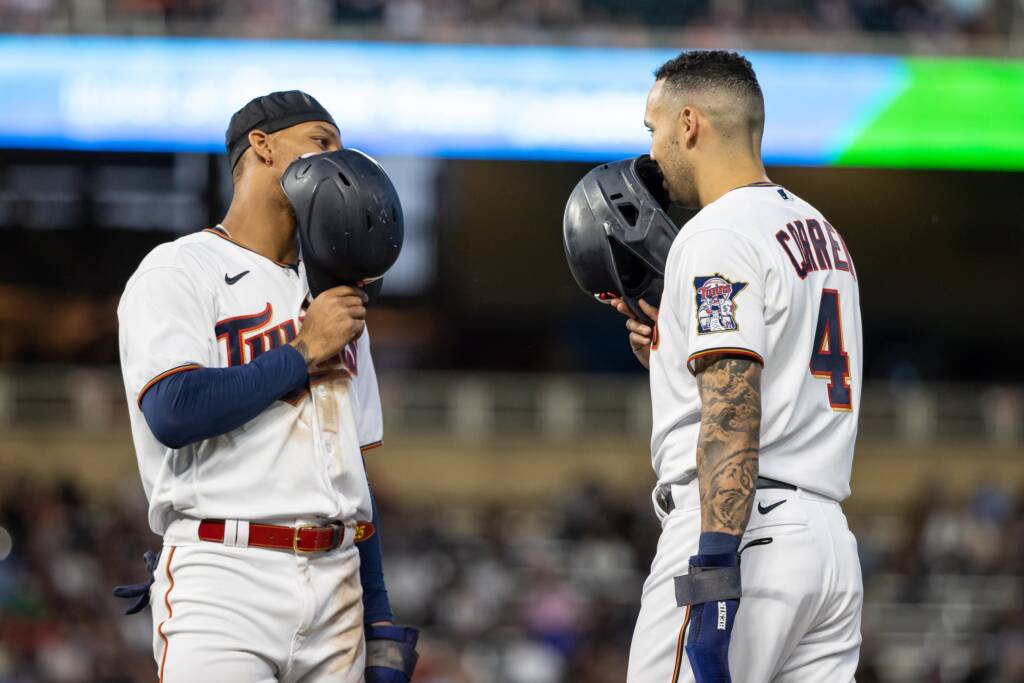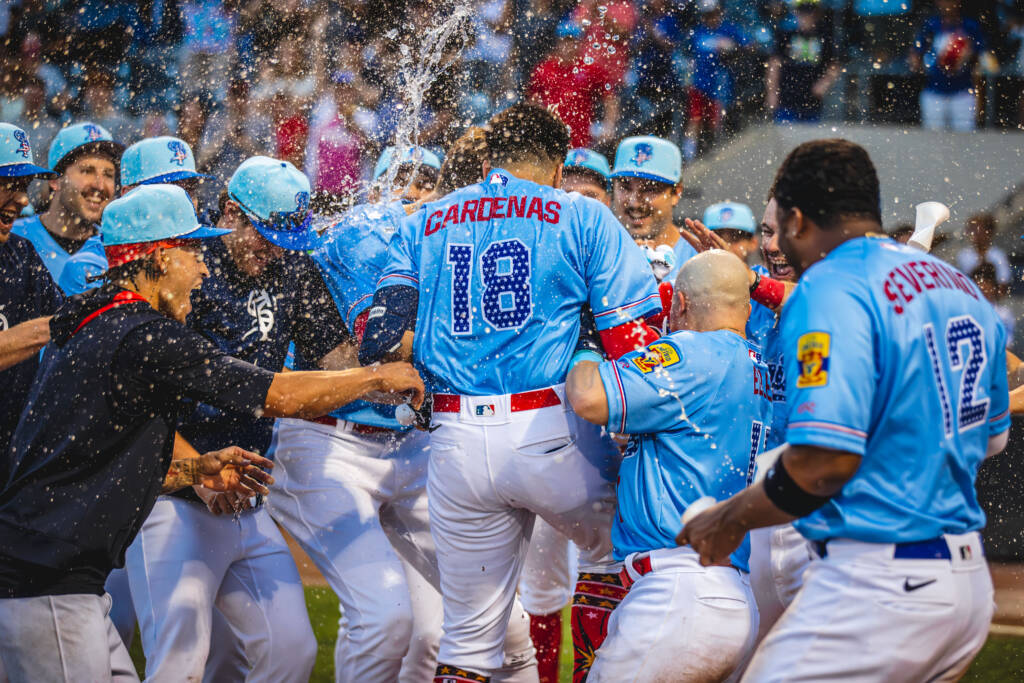The Minnesota Twins were bleary-eyed and cantankerous when they woke up in Cleveland on Sept. 14, 2019. Still, they were on the verge of snapping out of their doldrums. Years of ill-advised trades and poor player development had turned them into a sleepy organization, but the Bomba Squad had snapped it back to life.
So it’s hard not to blame them for being upset when the Cleveland Guardians pushed for a rainout that Friday, washing Jake Odorizzi’s strong start from history. Still, they woke up on Saturday ready to go. Eighteen innings of baseball in one day? If that’s what it takes to take command of the AL Central.
“The general feel of some of those games does lend itself to just the attitude of you kind of embrace the fatigue,” Rocco Baldelli said that Saturday morning. “You embrace the long day. You embrace the challenge of a very difficult day at the ballpark.”
The Twins were no strangers to long days at the ballpark in 2019. They won a 17-inning game over the Boston Red Sox on June 18, then lost an 18-inning battle with the Tampa Bay Rays on June 27. In doing so, they became the third team in 40 years to play a 17-inning game and a longer game within ten days of each other. On that Saturday, every at-bat where the hitter stepped out of the box to adjust his gloves felt like it took half an hour. Every pitching change felt like an eternity. It was hard not to feel sleep pressure mount in those moments, threatening to drag you from the diamond into the subconscious.
Fortunately, Major League Baseball has taken steps to curtail the length of games. They added a ghost runner on second in extra innings during the 2020 pandemic season and limited the number of pitching changes. This year, they added a pitch clock and limited shifts. Baseball fans love the game, but nobody wants to watch a contest drag on for four-plus hours. Football and hockey games usually last three, basketball two-and-a-half, and soccer two. Playing eight hours of baseball in one day? Or, worse yet, over ten in ten days? That’s taxing. It’s not good for the players, coaches, or fans.
“There are so many different changes that are coming into play at the same time,” Baldelli said at the beginning of spring training this year. “And then the permanent adoption of other rules — you add it all up, I don’t know where it’s going to land.
“The best teams are still going to win. You’re probably going to see the same teams that would have ended up in first place with the old rules with the new rules. That will eventually even out. The growing pains, we’re going to over-discuss and overreact probably to all of them.”
The Twins have already experienced some growing pains. Joey Gallo misunderstood the new shift rule in Minnesota’s first spring training game, and Carlos Correa forgot about the pitch clock. The star shortstop has also had to adjust to the new shift rule that bans infielders from starting an at-bat with their feet touching the outfield grass.
“I like playing deep and using my arm so I can get more range,” Correa said. “Those are the rules, so I’ve got to follow them. I was asking (the second base umpire) a bunch of questions to make sure I understood every single thing that they’re looking at. He told me that my heel can’t be touching the grass at any time and all that. Try to play as back as I can without breaking the rules.”
Baldelli said that spring training came quickly this year. The Twins pursued Correa after he signed with the San Francisco Giants and New York Mets and failed both physicals. They also traded away fan-favorite Luis Arraez for Pablo López and prospects and brought in Christian Vázquez. Plus, they had to adjust to the rule changes. But Baldelli said they were out in front of them. They wanted to play faster anyway.
We have some guys that we’re bringing in this year [who are] going to give our team a different feel, look, and ability out on the field. We’re going to be playing the game with different pace. The feel of Twins baseball is going to be a little different this year than it was in the past. Not that we were doing anything wrong in the past. I just think it’s going to be different, and it makes it fun for us to be able to take part in those things.
Derek Falvey suggested that Minnesota’s change in philosophy wasn’t a big lift on his end. Unlike in football and basketball, where managers can quickly overhaul rosters, changes happen glacially in baseball. Players take years to develop, and the league has a lengthy arbitration process. There are blockbuster trades and expensive signings, but the best teams maintain a strong core of players who learn to build off each other. Fortunately for Falvey and the front office, the league has implemented many of these changes in the minor leagues.
It changes a little bit of how we’re prepping the minor leaguers. We’ll have to see how the running game works with the catching position. Controlling the running game now becomes a little bit more, but we’ve been doing that. They’ve already been doing that, the shift restrictions.
You think about infield defense differently now. There was a period of time with the full shift you might be able to hide range for certain players. This wasn’t us, but the [Milwaukee] Brewers played [Mike] Moustakas at second [base] a couple of years ago. How they felt comfortable with that, shifting and protecting it a little bit worked. Obviously, you’re less inclined to do that, range becomes more of a factor.
But ultimately, MLB has implemented most of these rule changes in the minor leagues. Most players have encountered them before reaching the majors.
A lot of those guys for sure, our minor-leaguers have. At this point, what percentage of major leaguers have pitched with a pitch clock? The numbers are going way up. There are only so many [Justin] Verlanders and [Max] Scherzers and [Clayton] Kershaws that are still pitching at the big-league level. The rest of these guys at some point in the minor leagues dealt with some version of the clock.
We’ll get them used to it. The first day of pitcher-catcher meetings we sat down and went through everything again and made sure everyone was aware of how this is going to work, they’re going to implement a little stuff in the bullpen.
But in terms of changing my job, not a ton. Our focus still is utilizing the information we have from scouting reports to objective info to try and figure out who are the best players at the best positions and maybe a little bit more of an emphasis on the defensive ratings that we have for range and arm strength. You can’t position perfectly.
Still, Falvey and Co. did enough, because Baldelli feels he has the right mix of players to implement a faster pace.
The new players — the types of things they can do are going to make the game look a little bit different. I’m going to have to manage differently, we’re going to have to coach differently, and the players on the field are going to play differently than some of the seasons that we’ve had previously.
We’ve had some successful years playing a different type of game, but the athleticism factor is something that I can look at, that the guys we brought in generally have a good amount of that. They can go out there and do things on the field that we weren’t doing. We weren’t going to do them, we probably weren’t able to do them. But we’re going to play a very much more fast-paced, maybe action-packed, type of game.
In 2019, the Twins built a team that crushed the juiced baseball. Four years later, they’ve gotten out ahead of the pitch clock, larger bases, and fewer shifts.
It’s something we would have talked about regardless, but the changes in the rules only are going to emphasize this more. We were able to bring in some players that are very comfortable and good at playing this kind of baseball. In addition to bringing those guys in, you have rules that are going to encourage all kinds of action on the field that we didn’t have to deal with before.
That wasn’t going on before. It’s going to push us with more balls probably being put in play. That’s actually going to be the case. There’s going to be more space on the field to play with, you’re going to find more balls bouncing out there in the outfield. You’re probably going to see more singles being hit all around the field. We need to find a way to take advantage of that and win some games with our legs. And we have some guys who can do it.
Nelson Cruz, Miguel Sano, and Eddie Rosario headlined the Bomba Squad. They had five players finish the year with 30 or more homers. However, it’s fitting that Byron Buxton and Correa’s team is more oriented around athleticism. Baseball teams adapt or die. The 2019 and 2020 teams adapted with aplomb; the 2021 and 2022 teams died. Adjusting to a faster game is baseball Darwinianism at its finest.
“Games are going to feel very different, and the way we play the game is very different,” said Baldelli. “I vote for two-hour games.”
He flashed a smile as he finished that final sentence. Who can blame him? A lot of great things happened in 2019. But playing a 17-inning game and then an 18-inning one less than 10 days later wasn’t one of them.

